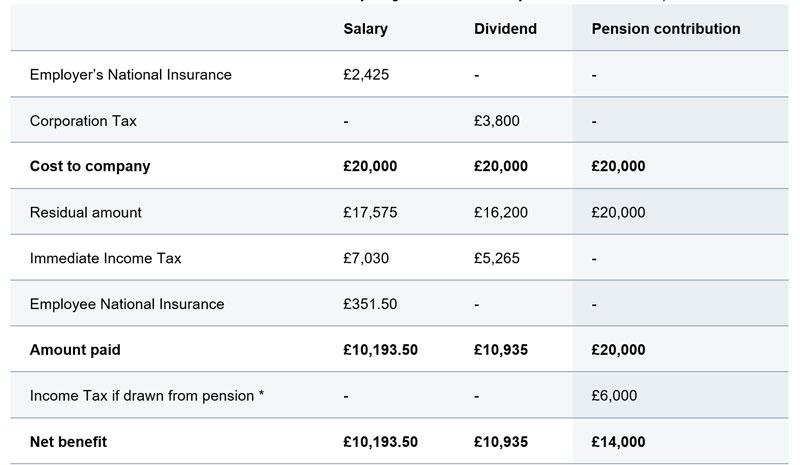
Could there be a more tax-efficient way to pay yourself through company profits?
If you’re one of the many business owners who have made a profit this past tax year you may be wondering how to extract those profits in the most tax-efficient way.
There are three main options available to you:
- Take more salary
- Pay extra pension contributions
- Pay a dividend
Depending on the option you choose, there are several considerations to make which are summarised below in this article:
National Insurance contributions
National Insurance (NI) contributions are paid on an employee’s salary, at a rate of 13.8% employer NI and a further 2% employee NI, or 12% if their salary is below the upper earnings limit. This is the biggest hit that payments could receive.
For example, £20,000 would suffer £2,425 employer NI. The residual would then suffer a further £2,109, if below the upper earnings limit, and that is even without Income Tax. If above the upper earnings limit however, the employee NI would be only £351.50.
Corporation Tax
Salary and pension contributions would generally be classed as “allowable business expenses”, and therefore would reduce the amount of corporation tax payable. This means that the whole amount can be used as the starting point for the payment.
On the other hand, dividends are not a business expense and will be subject to corporation tax. With corporation tax at 19%, this would reduce the payment made by £3,800.
Income Tax
Pension contributions are not taxed immediately but will eventually be subject to Income Tax at your marginal rate, although in most cases 25% will be paid tax-free. Growth is also generated tax-efficiently within the pension, which could increase the eventual tax paid or even subject the payment to a lifetime allowance charge.
The salary will be subject to your marginal rates of Income Tax. If you are earning at or near £100,000, you will need to be careful, as the loss of the personal allowance could make this option less attractive. In the example below, it is assumed that the whole amount will be within the higher rate band, so it is subject to 40% tax.
The same is true of dividends, although you may also have access to the dividend allowance of £2,000 depending on other dividends received. In the example below, we have assumed that this payment is in addition to dividends already taken, which has used the allowance. The higher rate tax on dividends is less than on salary at only 32.5%.
Inheritance Tax (IHT)
Although not an immediate tax, payments made to pensions should remain outside your estate for Inheritance Tax purposes. If your estate is already above the IHT nil rate band any further drawing, such as dividend or salary, that are not spent will just increase the estate and therefore the amount of IHT payable.
Annual allowance issues
For many, the tapered annual allowance won’t be an issue, but for those who it affects - including those that have already used their standard annual allowance - this will need to be considered.
The benefit of tax relief will be lost on anything over the value of your available annual allowance and carry forward, which may mean that a pension contribution is less favourable. The annual allowance can’t be ignored, but it shouldn’t be the sole driver for dismissing pension contributions as an option.
How salaries, dividends, and pension contributions compare for a company with £20,000 to distribute

Look at your current circumstances
We shouldn’t forget that pensions are a long-term investment that won’t help your day-to-day situation - you can’t buy groceries with a pension contribution. So, although it can be relatively easy to justify a pension contribution on the numbers alone, holistic planning requires you to have a good understanding of your own circumstances.
Take action now
There are many moving parts to extracting funds from a company. In reality, some if not all the three routes will be used each year to maximise the use of allowances and provide a useable income and protection for the future.
The levels and bases of taxation, and reliefs from taxation, can change at any time and are generally dependent on individual circumstances.


